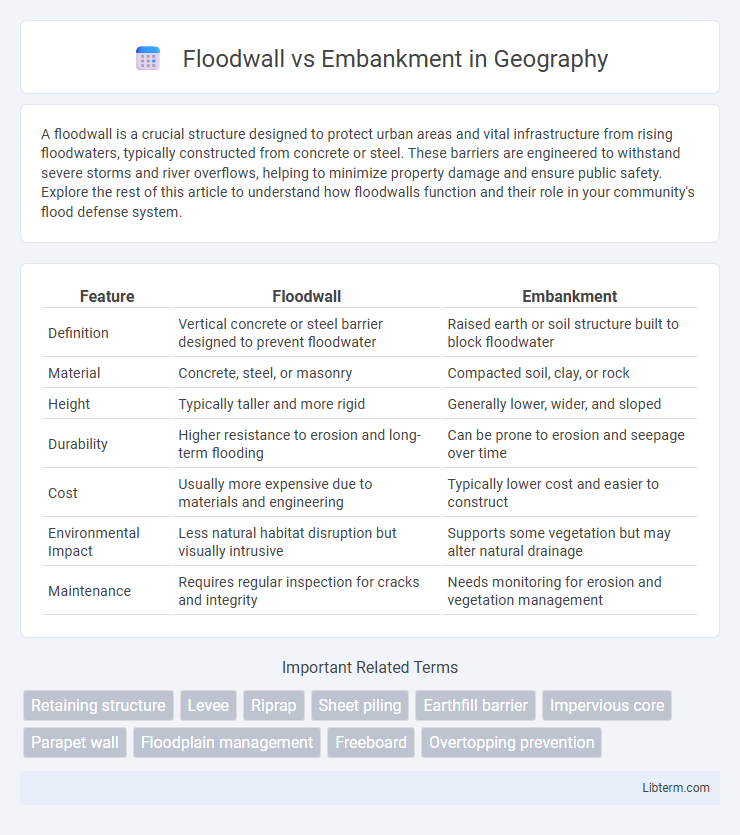A floodwall is a crucial structure designed to protect urban areas and vital infrastructure from rising floodwaters, typically constructed from concrete or steel. These barriers are engineered to withstand severe storms and river overflows, helping to minimize property damage and ensure public safety. Explore the rest of this article to understand how floodwalls function and their role in your community's flood defense system.
Table of Comparison
| Feature | Floodwall | Embankment |
|---|---|---|
| Definition | Vertical concrete or steel barrier designed to prevent floodwater | Raised earth or soil structure built to block floodwater |
| Material | Concrete, steel, or masonry | Compacted soil, clay, or rock |
| Height | Typically taller and more rigid | Generally lower, wider, and sloped |
| Durability | Higher resistance to erosion and long-term flooding | Can be prone to erosion and seepage over time |
| Cost | Usually more expensive due to materials and engineering | Typically lower cost and easier to construct |
| Environmental Impact | Less natural habitat disruption but visually intrusive | Supports some vegetation but may alter natural drainage |
| Maintenance | Requires regular inspection for cracks and integrity | Needs monitoring for erosion and vegetation management |
Introduction to Floodwall and Embankment
Floodwalls are vertical barrier structures made of concrete or steel designed to prevent floodwaters from inundating urban areas, offering high protection with limited footprint. Embankments, also known as levees or dikes, are earthen mounds constructed from compacted soil and rock that function to contain or redirect floodwaters over extended distances. Both floodwalls and embankments serve as critical elements in flood risk management, with design considerations tailored to site-specific hydraulic and geotechnical conditions.
Definition and Core Functions
Floodwalls are vertical barriers constructed from concrete or steel designed to prevent water from flooding a specific area by acting as a rigid, impermeable structure. Embankments, also known as levees or dikes, are raised mounds of earth or other materials built parallel to water bodies to contain or redirect floodwaters. While floodwalls provide high-strength, space-efficient protection in urban environments, embankments offer extensive, natural flood defense by increasing ground elevation to reduce water overflow.
Structural Design Differences
Floodwalls are vertical, rigid structures made primarily from reinforced concrete or steel, designed to resist high water pressure and prevent floodwaters from breaching urban areas. Embankments consist of earthen materials like compacted soil or rock, shaped into sloped mounds that rely on mass and slope stability to hold back floodwaters in less urbanized environments. The structural design of floodwalls emphasizes strength and impermeability with reinforcement to withstand hydrostatic forces, while embankments focus on height, slope gradient, and proper drainage to avoid erosion and seepage.
Materials Used in Construction
Floodwalls are primarily constructed using reinforced concrete and steel to provide a rigid, durable barrier capable of withstanding high water pressure and erosion. Embankments typically consist of compacted earth materials, such as clay, sand, and gravel, chosen for their permeability and stability to absorb and resist water flow. The choice between floodwall and embankment materials depends on site conditions, available resources, and required structural performance.
Installation and Maintenance Requirements
Floodwalls require specialized construction techniques involving reinforced concrete and steel, demanding precise engineering and heavy machinery for installation, whereas embankments utilize natural materials like soil and rock, allowing for simpler and quicker assembly. Maintenance of floodwalls involves regular inspections for cracks, joint integrity, and structural stability, often requiring skilled labor and costly repairs; embankments need monitoring for erosion, vegetation growth, and seepage, with maintenance typically involving grading, vegetation control, and soil reinforcement. The higher installation and maintenance costs of floodwalls are offset by their smaller footprint and higher durability compared to embankments, which require more land but offer easier access for routine upkeep.
Cost Comparison
Floodwalls generally have higher initial construction costs compared to embankments due to the use of concrete and steel materials, specialized labor, and engineering requirements. Embankments, typically made from earth or rock-fill, offer a more cost-effective solution, especially for large areas, but may require more land and ongoing maintenance expenses. Long-term cost considerations include floodwall durability and resistance to erosion versus embankment susceptibility to breaches and vegetation management.
Effectiveness in Flood Protection
Floodwalls provide a robust, vertical barrier that offers high effectiveness in flood protection, especially in urban areas with limited space, ensuring minimal land use and reliable water containment. Embankments, consisting of earthen levees, are effective for widespread floodplain management but require more land and maintenance to prevent overtopping and breaches. While floodwalls can withstand higher water pressures and are less prone to seepage, embankments are often preferred for their cost-efficiency and natural integration into the landscape.
Environmental Impact
Floodwalls, typically constructed from concrete or steel, can disrupt local ecosystems by creating impermeable barriers that inhibit natural water flow and wildlife movement, often resulting in habitat fragmentation. Embankments, made from earth materials, tend to blend more seamlessly with the environment, supporting vegetation growth and providing habitats but may increase sedimentation and alter groundwater patterns. Both structures impact hydrology and biodiversity differently, with floodwalls favoring urban flood protection and embankments offering more ecological benefits.
Suitability for Different Terrains
Floodwalls are ideal for urban areas with limited space due to their vertical design and small footprint, providing effective flood protection without requiring extensive land. Embankments are better suited for rural or open terrains where ample land allows for gradual slopes, offering natural integration with the landscape and enhanced stability. Selecting between floodwalls and embankments depends on terrain constraints, space availability, and specific flood defense requirements.
Choosing Between Floodwall and Embankment
Choosing between a floodwall and embankment depends on site-specific factors such as available space, cost, and environmental impact. Floodwalls offer higher protection in urban areas with limited footprint but are more expensive and visually intrusive compared to embankments. Embankments provide a natural barrier with easier integration into the landscape, making them suitable for rural settings where space is less constrained.
Floodwall Infographic

 libterm.com
libterm.com